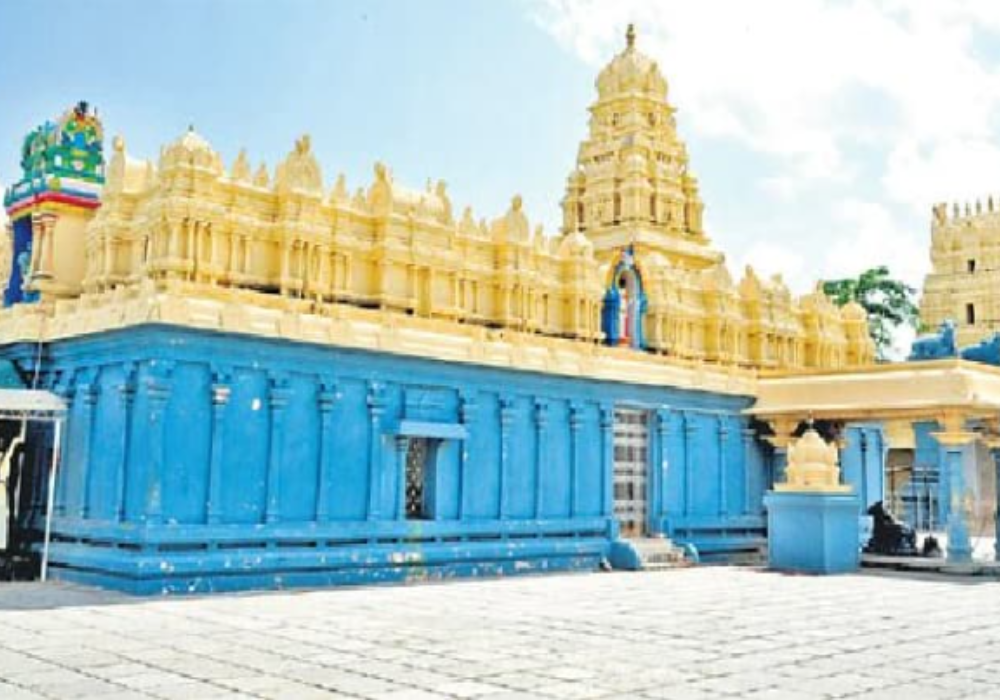
Nestled at the sacred confluence of the Godavari and Pranahita rivers, the Kaleshwaram Temple stands as a beacon of spiritual significance in Telangana. This ancient shrine is officially known as the Kaleshwara Mukteswara Swamy Temple. It attracts countless devotees seeking blessings and spiritual solace. Its unique spiritual essence, coupled with a rich Kaleshwaram temple history, makes it a prominent pilgrimage destination. Understanding the Kaleshwaram temple timings is essential for pilgrims. This ensures a smooth and enriching experience.
The Profound Significance of Kaleshwaram Temple
The Kaleshwaram Temple holds a distinguished position among Hindu temples. It is especially revered among those dedicated to Lord Shiva. It is one of the three Shiva temples that form the “Trilinga Desham”. This term translates to “Land of Three Lingas”. Historically, it refers to the Telugu-speaking regions of Andhra Pradesh and Telangana. The other two pivotal temples in this sacred triad are located at Srisailam and Draksharamam.
A Unique Dual Manifestation
What truly sets the Kaleshwaram Temple apart is its extraordinary sanctum sanctorum. Most Shiva temples house a single Lingam. However, this temple features two Shiva Lingams residing on a common pedestal. This is known as a Panavattam. This rare arrangement is often referred to as “Ekamreshwara Swaroopam”. One Lingam represents Lord Shiva as Mukteshwara. He is the liberator who grants moksha, or spiritual liberation. This breaks the cycle of birth and rebirth. The other Lingam symbolizes Lord Yama, known as Kaleshwara. He is associated with assigning life and death.
He ensures the continuous cycle of existence. This unique duality of life and death, creation and salvation, is a central theological concept. It is deeply embodied within the temple.
This dual manifestation highlights a profound philosophical principle. It speaks to the cyclical nature of existence. Devotees believe worshipping both deities here brings comprehensive spiritual benefits. It addresses both worldly existence and ultimate liberation. The presence of Kaleshwara and Mukteshwara together is a powerful symbol. It reminds pilgrims of life’s transient nature. It also emphasizes the path to eternal freedom.
The Confluence of Sacred Rivers
Another significant aspect contributing to the temple’s sanctity is its geographical location. The Kaleshwaram Temple is situated at the meeting point of the Godavari and Pranahita rivers. This confluence is particularly sacred. It is often referred to as “Dakshina Triveni Sangamam”. It is believed that a third, invisible river, the Saraswati, also merges here. Taking a holy dip in these sacred waters is a customary ritual for devotees. It is believed to cleanse sins and bestow spiritual benefits. The spiritual potency of this Triveni Sangamam attracts pilgrims. They seek purification and divine blessings.
The river Godavari itself is considered one of India’s most sacred rivers. It is often called “Dakshina Ganga” or “Southern Ganges”. Its confluence with the Pranahita, a major tributary, creates a powerful spiritual vortex. The belief in the mystical presence of Saraswati further elevates its sanctity. This makes the ritual bath deeply meaningful for pilgrims.
Delving into Kaleshwaram Temple History

The Kaleshwaram temple history stretches back through ancient times. Its roots are deeply embedded in local folklore and religious texts. While an exact date of establishment is difficult to pinpoint, the temple, in its current form, has existed for centuries. It possibly dates back over a thousand years.
Legends of Divine Origin
Several captivating legends surround the origin of the Kaleshwaram Temple. One popular story suggests that Lord Shiva himself established the temple. He appeared as Kaleshwara and Mukteswara to absolve the sins of devotees. Another legend recounts the tale of Sage Vyasa. He is the revered author of the Mahabharata and is said to have performed penance at this site. He consecrated the dual Lingams. This made it a significant place for those seeking salvation.
Furthermore, an intriguing myth involves Yama, the god of death. According to this legend, Yama once visited Kaleshwaram. He performed intense penance to please Lord Shiva. Pleased by his devotion, Lord Shiva granted Yama a boon. Whoever bathes in the sacred waters at the confluence and then worships the Lingams would be relieved of anxieties and attain moksha. This legend explains why pilgrims often pray to Yama (Kaleshwara) first. They then proceed to Lord Shiva (Mukteshwara).
Another account from the Kaleshwara Kanda states that Lord Shiva commanded Yama. He manifested as Mukteswara. This ensured that those who do not visit Kaleshwaram would face punishments in Yama Loka. This highlights the temple’s unique power. It offers salvation simply by darshan, or sight. This is a significant distinction from other sacred sites. For example, in Kashi, salvation is often associated with dying there.
Historical Patronage and Development
Historical records and inscriptions offer glimpses into the temple’s fascinating past. They also show its patronage by various dynasties. The temple’s construction is often associated with the Kakatiya dynasty. Inscriptions from 1171 CE at Nagunur indicate that Ellanki Gangadhar built the Shiva temple at Kaleshwaram. He was a minister of Kakatiya Rudradeva. The Western Chalukyas also had influence in the region in the 12th century. King Jagadekamalla attempted to strengthen his rule. He annexed the Manthani region. Over the centuries, the temple has undergone numerous renovations and restorations. Each contributed to its present grandeur. The Kakatiya architectural style is evident. It reflects precision and aesthetic beauty.
Archaeological discoveries near the Kaleshwaram Lift Irrigation Project have further illuminated the region’s past. A medieval-era statue of Kalabhairava and a sandstone door were unearthed. These are believed to be from the Kakatiya or Padmanayaka dynasty. This underlines the area’s rich historical layers.
The Unfillable Lingam Mystery
Among the many intriguing features of the Kaleshwaram Temple is a mysterious hole in the Mukteshwara Lingam. It reportedly cannot be filled with water. This holds true no matter how much is poured into it. This phenomenon has puzzled researchers and devotees alike. Some theories suggest an underground passage. It might connect to the Godavari River. Others propose a connection to the mythical Saraswati River. This unexplained marvel adds to the temple’s mystic charm. It continues to trigger curiosity about its ancient secrets.
Devotees believe this unique characteristic is a divine manifestation. It signifies the Lingam’s boundless nature. The water poured during Abhishekam rituals seemingly disappears. This reinforces the temple’s spiritual enigma.
Architectural Splendor of Kaleshwaram Temple
The architectural design of the Kaleshwaram Temple is a testament to rich South Indian temple building traditions. It showcases intricate carvings and sculptures. These adorn its walls and pillars. They depict various deities and mythological scenes. The temple’s design reflects the grandeur of the Kakatiya architectural style. This style is known for its precision and aesthetic beauty.
Key Architectural Features
The use of durable materials and sophisticated construction techniques has ensured the preservation of this magnificent temple through centuries. This allows its spiritual and cultural heritage to endure. The temple’s architecture is not merely structural. It is a canvas for spiritual storytelling. It showcases the artistic prowess of its builders.
Planning Your Visit: Kaleshwaram Temple Timings and More

For pilgrims and tourists planning to visit the Kaleshwaram Temple, understanding the operational hours is crucial. Other practical details also ensure a smooth experience. The temple generally maintains consistent kaleshwaram temple timings. However, these can vary during special occasions and major festivals.
General Kaleshwaram Temple Timings
The temple typically opens its doors early in the morning. It then closes for a midday break. It reopens in the evening. Here are the general timings:
It is important to note that these kaleshwaram temple timings are subject to change. This is especially true during festivals and special religious days. Therefore, it is always advisable to confirm the timings beforehand. This is particularly important if you are traveling for a specific ritual or during peak seasons. You can check the official temple information for the most current schedule.
Pooja and Ritual Timings
Various daily rituals and poojas are performed at the temple. For instance, Sarva Darshan and Abhishekam are typically conducted from 7:00 AM to 12:30 PM. Nitya Kalyanam, a daily ceremonial wedding ritual for the deities, usually takes place between 9:30 AM and 10:30 AM. Anna Puja and Nivedana (food offerings) are performed around 12:30 PM to 1:00 PM. Knowing these specific timings can help devotees witness or participate in these sacred ceremonies. Other special rituals include Rudrabhishekam, Shani Puja, Kaalasarpa Dosha Nivarana Puja, Kumkum Archana, Surya Puja, Lakshapatri Puja, Shiva Kalyanam, Anna Puja, and Chandi Homam.
Best Time to Visit
While the temple welcomes devotees throughout the year, the winter months offer more pleasant weather. This period spans from October to February. The temple experiences a significant influx of pilgrims during the Karthika Masam. This is from mid-November to mid-December. It also sees large crowds during the Maha Shivaratri festival. These periods are vibrant with activity and devotion. They offer a unique spiritual experience. However, they can also be very crowded. For a more tranquil visit, consider weekdays during off-peak seasons.
Accommodation and Accessibility
For visitors, various accommodation options are available near the temple. These range from budget-friendly guesthouses to comfortable hotels. Advance booking is recommended, especially during peak seasons or festivals. Telangana Tourism offers a Haritha Hotel. It provides modern facilities and AC accommodation.
The Kaleshwaram Temple is well-connected by road. State-run bus services are available from major cities. These include Hyderabad, Warangal, and Karimnagar. Private taxis can also be hired for a more comfortable journey. The nearest major airport is Rajiv Gandhi International Airport in Hyderabad. It is approximately 277 km away. For those traveling by train, Mancherial, Ramagundam, and Warangal/Kazipet are among the closest railway stations.
Festivals and Celebrations at Kaleshwaram Temple
The Kaleshwaram Temple is a hub of vibrant spiritual activity. This is especially true during its annual festivals. These celebrations draw thousands of devotees. They come from various states. These include Telangana, Maharashtra, Andhra Pradesh, and Chhattisgarh.
Maha Shivaratri
Maha Shivaratri is undoubtedly the pinnacle of celebrations at the Kaleshwaram Temple. This grand festival is dedicated to Lord Shiva. It sees a massive gathering of pilgrims. They come to offer prayers. They witness the divine energy permeating the temple. The atmosphere during Maha Shivaratri is filled with rhythmic chants. Devotional songs and the fragrance of incense create an intensely spiritual ambiance. Devotees fast, pray, and stay awake all night. This is done to worship Lord Shiva.
Karthika Masam
The month of Karthika (mid-November to mid-December) is another highly auspicious period. It is significant for devotees visiting the Kaleshwaram Temple. During this time, the temple experiences a significant surge in visitors. All engage in various rituals and seek blessings. Holy baths in the Godavari and Pranahita rivers are a common practice during this sacred month. Devotees light lamps every day. They also take part in special prayers.
Saraswati Pushkaralu
The Saraswati Pushkaralu is a rare and highly auspicious Hindu festival. It occurs once every 12 years. This happens when the planet Jupiter moves into the Gemini sign. The Kaleshwaram Temple becomes a central point for this festival. It is at the confluence believed to include the mystical Saraswati River. During the 12-day event, thousands of devotees gather. They take holy dips in the river and also perform rituals like tarpanam. They participate in spiritual discourses and homams. This festival is dedicated to honoring River Saraswati. She is the goddess of knowledge and wisdom. It is believed to wash away sins and promote spiritual growth.
Other Rituals and Poojas
Throughout the year, the temple conducts various special rituals and prayers. These include Rudrabhishekam, Shani Puja (Saturn Worship), Kaalasarpa Dosha Nivarana Puja, Kumkum Archana, Surya Puja (Sun Worship), Lakshapatri Puja, Shiva Kalyanam, Anna Puja, and Chandi Homam, among others. These diverse offerings cater to different spiritual needs and beliefs of the devotees. This makes the temple a comprehensive center for worship. Many people offer vows or pledges to Goddess Shubhananda Devi. They believe their wishes will undoubtedly be fulfilled.
The Kaleshwaram Lift Irrigation Project: A Modern Marvel Near the Ancient Shrine
While the Kaleshwaram Temple is steeped in ancient history, the region also hosts a modern engineering marvel. This is the Kaleshwaram Lift Irrigation Project (KLIP). This ambitious project is located approximately 35 kilometers from the temple. It is one of the world’s largest multi-stage lift irrigation schemes and aims to provide irrigation water to vast agricultural lands in Telangana. It does this by lifting water from the Godavari River. While distinct from the temple’s spiritual domain, the project has brought significant development to the surrounding areas. It often draws interest from visitors to the temple.
The KLIP is designed to provide water for irrigation and drinking purposes. It serves about 45 lakh acres across 20 districts in Telangana. This includes Hyderabad and Secunderabad. The project comprises seven links and 28 packages. It stretches approximately 500 km through 13 districts. It utilizes a canal network of over 1,800 km. The project aims to produce 240 TMC (Thousand Million Cubic Feet) of water. This water is allocated for various uses. These include irrigation, municipal water supply, industrial use, and drinking water. Four major pumping facilities manage the project’s outflow. The largest is at Ramadugu. It is expected to be the largest in Asia. This massive infrastructure is a testament to modern engineering capabilities. It addresses critical water needs in the region.
Nearby Attractions and Spiritual Ecosystem
A visit to the Kaleshwaram Temple can be part of a broader exploration. This includes the region’s spiritual and natural beauty. The temple is located in the Jayashankar Bhupalpally district of Telangana. This area offers several other points of interest.
Other Temples in the Vicinity
The area around Kaleshwaram is dotted with other shrines. This creates a rich spiritual ecosystem. These include the Shubhananda Devi Temple. It is dedicated to Goddess Parvati, consort of Mukteshwara. Other temples are the Saraswati Devi Temple, Sri Rama Temple, Adi Mukteswara Temple, Sangameshwara and Dattatreya Temple, Sri Anjaneya Swamy Temple, and Sri Surya Temple. Each of these temples adds to the spiritual allure of the region. They offer diverse avenues for worship and contemplation.
Natural Beauty and Wildlife
Beyond the religious sites, visitors can explore the natural beauty of the area. The confluence of the Godavari and Pranahita rivers itself is a picturesque spot. Nearby attractions include the Pranahita Wildlife Sanctuary and Laknavaram Lake. These offer opportunities for nature enthusiasts. The lush greenery, riverbanks, and peaceful surroundings make Kaleshwaram a perfect retreat. Visitors can enjoy boat rides and scenic walks along the riverbanks.
The region’s biodiversity makes it attractive for eco-tourism. Birdwatching and photography are popular activities. The serene environment offers a peaceful escape from city life.
Embracing the Spiritual Journey at Kaleshwaram
The Kaleshwaram Temple offers a unique blend of historical depth, architectural magnificence, and profound spiritual energy. It is a place where ancient legends intertwine with the tangible presence of divinity. It draws pilgrims from across the country and beyond. The distinctive dual Shiva Lingams embody profound concepts of life and death. The sacred river confluence and the mysterious unfillable Lingam all contribute to an aura of mystique and wonder. Whether one seeks divine blessings, historical insights, or simply a tranquil retreat, a visit to this sacred site promises an enriching and memorable experience.
Embracing the customs and rituals with respect and reverence allows the divine essence of Kaleshwaram to truly touch one’s soul.
The temple’s enduring legacy is a testament to its deep cultural roots. It continues to inspire generations of devotees. The serene atmosphere invites introspection and spiritual growth. A visit here is more than just sightseeing. It is an immersive journey into faith and heritage. This sacred destination provides a profound connection to India’s enduring spiritual legacy.
Frequently Asked Questions about Kaleshwaram Temple
What is the Kaleshwaram Temple famous for?
The Kaleshwaram Temple is primarily famous for its unique feature. It houses two Shiva Lingams on a single pedestal. They represent Lord Shiva (Mukteshwara) and Lord Yama (Kaleshwara). It is also significant due to its location. It lies at the confluence of the Godavari and Pranahita rivers. The mythical Saraswati River is also believed to meet here.
Where is the Kaleshwaram Temple located?
The Kaleshwaram Temple is located in Kaleshwaram village. This is within the Mahadevpur Mandal. It is in the Jayashankar Bhupalpally district of Telangana, India. It lies on the border of Telangana and Maharashtra.
What are the general Kaleshwaram Temple timings?
The general kaleshwaram temple timings are typically from 6:30 AM to 2:00 PM for morning darshan. Evening darshan is from 4:30 PM to 8:00 PM. However, these timings can vary. This is especially true during festivals and special occasions. It is advisable to confirm them before your visit.
What is the Kaleshwaram Temple history?
The kaleshwaram temple history is ancient. Its origins are intertwined with various legends and myths. Historical records suggest that the temple has existed for centuries. It saw significant contributions during the Kakatiya dynasty. Minister Ellanki Gangadhar built a Shiva temple here in 1171 CE.
Are there two Lingams in Kaleshwaram Temple?
Yes, the Kaleshwaram Temple is unique for having two Shiva Lingams on a single pedestal. One Lingam is Lord Shiva (Mukteshwara). The other is Lord Yama (Kaleshwara). This symbolizes the duality of life and death.
What is the mystery of the Mukteshwara Lingam?
An intriguing mystery of the Mukteshwara Lingam is a hole. It cannot be filled with water. This holds true regardless of the quantity poured into it. Researchers have been unable to fully explain this phenomenon. Some speculate an underground passage connects it to the Godavari River. Others suggest a connection to the mystical Saraswati River.
What festivals are celebrated at Kaleshwaram Temple?
Major festivals celebrated at the Kaleshwaram Temple include Maha Shivaratri and the Karthika Masam. Additionally, the rare 12-yearly Saraswati Pushkaralu is a significant event. It draws large crowds to the sacred confluence.
Is Kaleshwaram considered a Jyotirlinga?
While Kaleshwaram is one of the three Shiva temples in “Trilinga Desham,” which are considered very significant, some sources suggest that these three temples (Kaleshwaram, Draksharamam, and Srisailam) are regarded as Jyotirlingas, symbolizing the cosmic power of Lord Shiva. However, it is important to distinguish this from the 12 primary Jyotirlingas recognized across India.
How far is Kaleshwaram Temple from Hyderabad?
The Kaleshwaram Temple is approximately 277 kilometers from Hyderabad by road. It is well-connected by bus services from major cities in Telangana.
What is the significance of the river confluence at Kaleshwaram?
The confluence of the Godavari and Pranahita rivers at Kaleshwaram is considered highly sacred. It is often referred to as “Dakshina Triveni Sangamam.” It is believed that the mythical Saraswati River also flows underground here. This makes it a powerful site for holy dips and spiritual purification.
Conclusion
The Kaleshwaram Temple, with its deep spiritual resonance and captivating heritage, offers a truly unique pilgrimage experience. From its extraordinary dual Shiva Lingams, embodying the profound concepts of life and death, to its sacred location at the confluence of revered rivers, every aspect of this shrine beckons devotees and curious travelers alike. The rich kaleshwaram temple history, woven with ancient legends and historical patronage, adds layers of mystique and cultural significance. Moreover, understanding the practical aspects like kaleshwaram temple timings empowers visitors to plan a seamless and deeply immersive journey. As a timeless sanctuary where spirituality and history converge, the Kaleshwaram Temple stands as a powerful testament to faith and architectural grandeur, leaving an indelible mark on the hearts of all who visit. It is a destination that not only offers divine blessings but also provides a profound connection to India’s enduring spiritual legacy.

Binu Lamba
Binu Lamba is a 29-year-old editor and fact-checker with 7 years of experience in travel content. He verifies all location details, hotel recommendations, and travel tips to ensure our guides are accurate, updated, and helpful for readers planning real trips.

AI Assistant
Our AI writing assistant supports the creation of travel content under strict human supervision. All AI-generated posts are thoroughly reviewed, fact-checked, and updated by our team to maintain trust and accuracy in our travel recommendations.

“Weather in Srinagar: Month-by-Month Guide to the Climate in Kashmir’s Heart”
Planning a trip to Srinagar and wondering what to expect from the weather? Whether you’re visiting for the scenic Dal Lake views, historic Mughal gardens,

“Gulmarg Weather: What to Expect All Year Round”
Planning a trip to Gulmarg? Before you pack your bags, it’s a good idea to understand Gulmarg weather. Whether you’re heading there for skiing, sightseeing,

The Ultimate Guide: Unveiling the Best Way to Reach Pune
If you’re planning a trip to Maharashtra, knowing how to reach Pune is a good starting point. Pune is a major city that’s well connected








